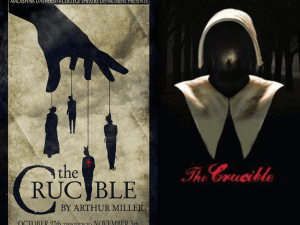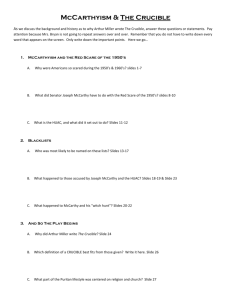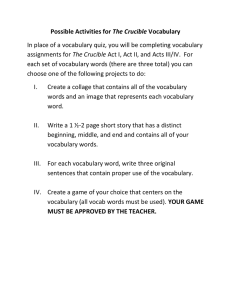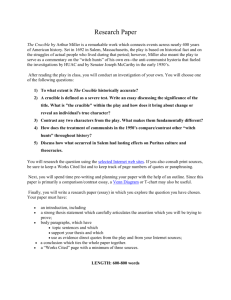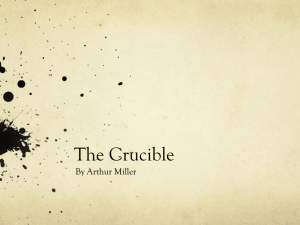The Crucible relates to McCarthyism because both
advertisement
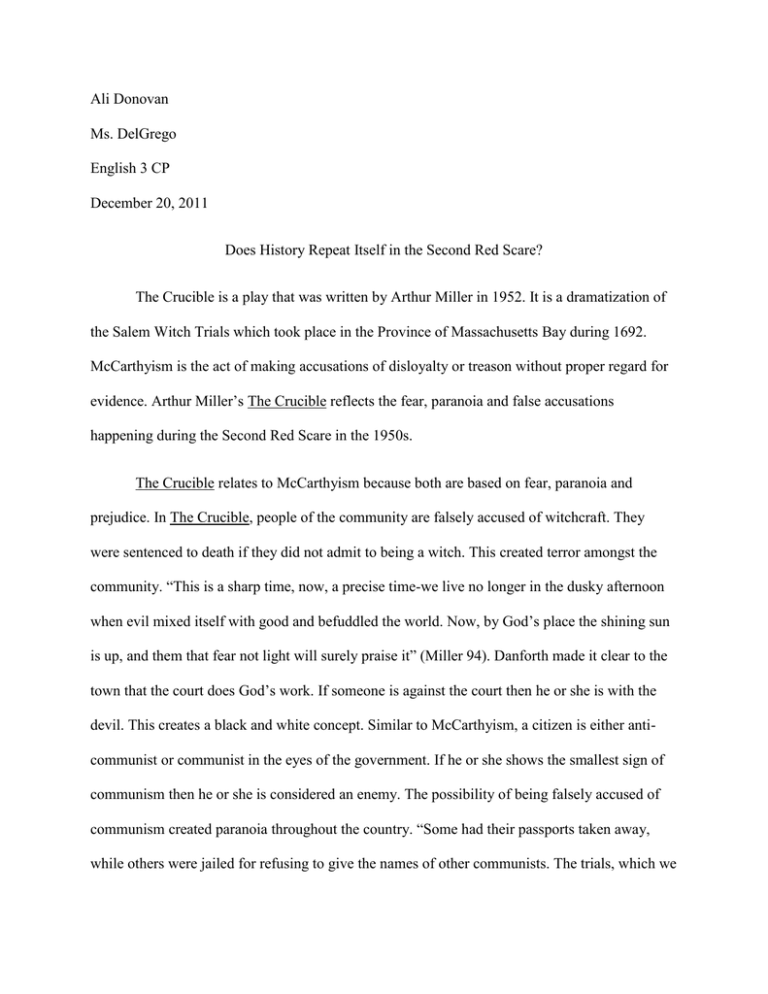
Ali Donovan Ms. DelGrego English 3 CP December 20, 2011 Does History Repeat Itself in the Second Red Scare? The Crucible is a play that was written by Arthur Miller in 1952. It is a dramatization of the Salem Witch Trials which took place in the Province of Massachusetts Bay during 1692. McCarthyism is the act of making accusations of disloyalty or treason without proper regard for evidence. Arthur Miller’s The Crucible reflects the fear, paranoia and false accusations happening during the Second Red Scare in the 1950s. The Crucible relates to McCarthyism because both are based on fear, paranoia and prejudice. In The Crucible, people of the community are falsely accused of witchcraft. They were sentenced to death if they did not admit to being a witch. This created terror amongst the community. “This is a sharp time, now, a precise time-we live no longer in the dusky afternoon when evil mixed itself with good and befuddled the world. Now, by God’s place the shining sun is up, and them that fear not light will surely praise it” (Miller 94). Danforth made it clear to the town that the court does God’s work. If someone is against the court then he or she is with the devil. This creates a black and white concept. Similar to McCarthyism, a citizen is either anticommunist or communist in the eyes of the government. If he or she shows the smallest sign of communism then he or she is considered an enemy. The possibility of being falsely accused of communism created paranoia throughout the country. “Some had their passports taken away, while others were jailed for refusing to give the names of other communists. The trials, which we well publicized, could often destroy a career with a single unsubstained accusation” (McCarthyism1). The consequences were exaggerated. People were disappearing left and right for a belief they did not even believe in. The thought of “being next” had American citizens on edge, terrified for their lives. The only way out of danger for oneself seemed to be putting the blame on others. Throughout The Crucible is a vicious cycle of accusing others and blaming them to selfishly help keep themselves from being executed. Salem began as a small close-knit community in which neighbors helped neighbors and an evil did not really exist. Unfortunately, it is not known for that. But rather for the people who lost their identity when it came down to saving themselves instead of fighting as a community for the truth. “I want to open myself! I want the light of God, I want the sweet love of Jesus! I danced for the Devil; I saw him, I wrote in his book; I go back to Jesus; I kiss His hand. I saw Sarah Good with the Devil! I saw Goody Osborn with the Devil! I saw Bridget Bishop with the Devil!” (Miller48). Abigail caused most of the false accusation which created a barbarous circle of lies. Once one person started to play the blame game, others believed that it was okay for them to as well. The fear of death drove people to give up the names of others which is also what happened in the Second Red Scare. Elia Kazan, director of “The Death of a Salesmen” written by Miller, released eight names of fellow members in a communist party in his testimony. “Kazan later claimed he felt no guilt about what he had done: ‘There’s a normal sadness about hurting political, but I’s rather hurt them a little than hurt myself a lot’ (Kazan 1).” When it came down to it, Kazan did not feel guilty about naming others involved. He only cared about the outcome of himself. In both, The Crucible and the Second Red Scare, the bottom line is that most people of society will narrow-mindedly choose to hurt others at all costs to save themselves. McCarthyism in the 1950s is history repeating the Salem Witch Trials in the 1690s. Both eras included a time in which society was forced into fear and a state of paranoia by their government. When put in a life or death situation, most people chose to live regardless of the people they were indirectly hurting or even executing. Arthur Miller’s The Crucible reflects the fear, paranoia and false accusations happening during the Second Red Scare in the 1950s.
